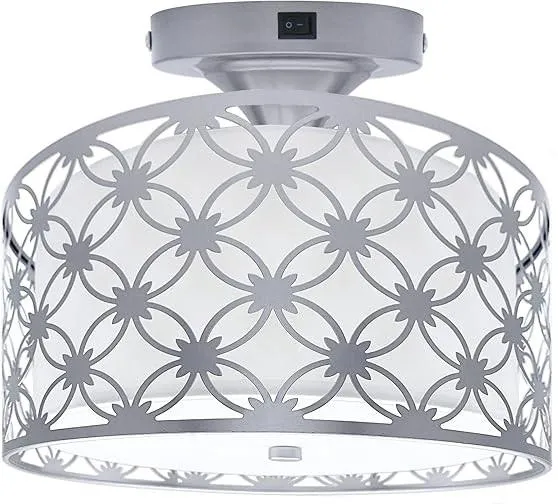Choosing and Updating 12V Light Fixtures for Your RV or Boat
Published: 10/01/2025

Beautiful 12V RV Pendant Light Fixture
Upgrading the interior lighting in your RV, camper, trailer, or boat is the single fastest and most impactful way to modernize and personalize your mobile space.
The great news for design enthusiasts is that you are no longer confined to ugly, factory-installed fixtures!
In fact, you can often use stylish residential light fixtures to achieve the popular modern farmhouse, bohemian, or industrial looks seen in home design or I have created a list of styllish 12 Volt fixtures. Sconces, pendants, reading lights and vanity lights are all here!
In this guide, we'll walk you through:
- The "Simple Secret" of when and how you can safely use stylish residential fixtures in a 12V system.
- The crucial difference between using a light controlled by a wall switch versus one controlled by a switch on the fixture itself.
- A quick DIY guide to safely changing out an old 12-volt light switch.
- A list of beautiful 12 Volt fixtures from Amazon.
We've gathered a wide variety of the most stylish 12 Volt light fixtures from Amazon in all the latest designs, sizes, and colors.
Here is your ultimate guide to choosing the perfect modern 12V fixtures for every area of your space! Find the perfect light to complement your space by shopping our selections here.
Shop 12 Volt Lights on AmazonWhy a Dedicated 12V Option May Be Best
While you can use a residential light fixture with a compatible 12V DC bulb in your RV, a dedicated 12V RV fixture is often preferred for several practical reasons:
Durability: RV fixtures are designed to handle the vibration and movement of travel better than standard residential lights.
Size and Profile: They are usually lower-profile and more compact (like "pancake" lights) to maximize limited headroom and fit RV ceiling/wall depths.
Easy Installation: RV fixtures are typically designed as direct replacements, making wiring and mounting quicker.
Integrated Features: Many come with built-in switches, dimmers, or USB charging ports, simplifying your setup.
The most important thing is always to use a 12V DC bulb to match your RV's low-voltage electrical system, regardless of the fixture you choose.
Dimmers: 12V DC systems require specific PWM (Pulse-Width Modulation) dimmers, not the phase-cut (TRIAC) dimmers used in 120V residential wiring. If your fixture is on a dimmer, you must replace that dimmer switch with a 12V DC PWM-compatible dimmer switch if you want your new LED light to work properly. Many simple 12V LED replacement bulbs are not dimmable at all.
Light Bulb Color: (Color Correlated Temperature - CCT) Standardize on one CCT for the entire interior to create a cohesive, pleasant atmosphere. For a warm, inviting room, choose a "Soft/Warm White" 2700K to 3000K CCT to mimic traditional incandescent lighting. While maintaining that standard across the living area, you may consider a brighter "Daylight" or "Cool White" 4000K to 5000K CCT specifically for task-oriented areas like vanities, reading lamps, or the galley, as the whiter light improves focus and visibility.
When You Can Use Residential Fixtures
You can successfully use a stylish residential light fixture (designed for standard 120V household power) in your 12V RV or boat circuit—IF the fixture meets two primary, essential conditions.
1. Choose a "Dumb" Fixture (Simple Wiring)
The residential fixture must be a simple, traditional design that does not contain any complex integrated electronics, drivers, or transformers.
Look for a fixture that only includes:
- A metal or plastic shell (the body).
- A ceramic or plastic bulb socket (e.g., the standard E26/E27 screw-in base).
- Basic wiring connecting the socket directly to the main junction/power source.
If the fixture is a complex LED model or has specialty dimming components, it likely won't work. Stick to simple pendants, sconces, or flush mounts designed for traditional incandescent bulbs.
2. Use the Correct 12-Volt (12V) DC LED Bulb
This is the critical step! You must replace the standard 120V household bulb (which would instantly burn out and pose a serious fire hazard on a 12V system) with a specific type of bulb:
The Simple Swap:
- Choose a residential fixture with a standard, simple socket (like an E26 screw-in base).
- Replace the standard 120-volt (120V) household bulb with a compatible 12-volt (12V) DC LED bulb that has the matching base.
This smart, safe trick allows your stylish fixture to run efficiently on your camper's low-voltage DC battery system, finally delivering the popular, modern aesthetic you crave. Look specifically for "12V DC" or "RV/Marine" LED bulbs in the style you prefer (like Edison, globe, or standard A19 shapes).
When You Cannot Use a Residential Fixture
The one time you must avoid using a residential fixture in this manner is if it contains integrated electronics.
This is common with many modern, all-in-one LED fixtures.
Integrated LED Fixtures: If a fixture has a built-in LED array (a light panel or non-replaceable LEDs) that doesn't use a standard screw-in or pin-base bulb, it likely contains a driver (a small circuit board). This driver is specifically designed to convert the 120V AC household current to the low-voltage DC required by the LEDs.
The Problem: If you connect a fixture with a 120V AC driver to your 12V DC battery system, the driver will not work correctly, and the light will either not turn on, flicker, or be damaged.
In summary, as long as the residential fixture is simple and only serves as a decorative holder for a bulb with a standard base, the conversion is a popular and effective way to modernize your RV or boat.
When It is Unsafe to Use a Residential Fixture
While a residential fixture can often be used, it becomes a problem or is potentially unsafe in an RV or boat if:
1. The Fixture is Wired to the 120V AC Circuit (and a 12V Bulb is Inserted):
The Danger: If the residential fixture is connected to the RV's high-voltage 120V AC (shore power/generator) circuit and you accidentally screw in a 12V DC bulb (even if it fits the socket), the bulb will instantly receive approximately 10 times its intended voltage.
The Result: This will cause the 12V bulb to burn out immediately, often resulting in a flash, smoke, or even a small explosion/shattering of the bulb, posing a fire and injury risk. This is the main safety risk to avoid.
2. The Fixture is a Low-Quality Residential Fixture in a Marine/Wet Environment (Boat):
Residential fixtures are not designed for the harsh, corrosive environment of an RV or boat (especially saltwater).
The Problem: The materials, finishes, and internal components may quickly corrode or fail due to moisture and salt, leading to a loss of function or, in extreme cases, electrical shorts.
3. The Fixture's Internal Wiring is Not Rated for High Current (Less of a concern with modern LEDs, but important):
Low-voltage (12V) systems require much higher amperage (current) to deliver the same power as high-voltage (120V) systems.
The Problem: If you were to put a high-wattage 12V incandescent bulb (which draws many amps) into a residential fixture that has thin wiring only minimally rated for 120V current draw, the excess current could theoretically overheat the wire in the fixture.
Note: Since most people use very low-draw 12V LED bulbs in RVs/boats, this is rarely an issue, but it is a theoretical electrical limitation of using a low-voltage circuit.
4. The Residential Switch is Installed on a Polarity-Sensitive Circuit:
Most RV/marine light switches simply interrupt the positive (+) power wire, making the switch itself non-polarity sensitive.1
The Problem: However, if you use a residential light switch that contains an indicator light (a small light that glows when the switch is off), that indicator light is often a polarity-sensitive LED. If the switch is wired backward (negative to the side meant for positive), the indicator light may not work at all, even though the main light fixture will still switch on and off correctly. This is a functionality issue, not a safety risk, but it means the new switch isn't working as designed.
5. The 12V LED Bulb is Polarity-Sensitive (Less Common, but possible):
If you install a residential fixture and wire it to a DC power source (which has a positive and negative pole), an older or cheaper 12V LED bulb that lacks an internal bridge rectifier may be polarity-sensitive.
The Problem: If the wiring is reversed (positive to negative and vice versa), the bulb simply will not light up but should not be damaged. Most modern 12V LED bulbs for RV/marine use include internal protection to work regardless of which wire is connected to positive/negative.
The essential rule for safety is: Always verify the fixture is wired to 12V DC before inserting a 12V bulb, and be mindful of the corrosive environment for boats.
Wall Switch vs. Fixture Switch: The 12V Swap Rule
The rule for replacing 12-volt (V) lighting in an RV or vehicle depends entirely on where the power is controlled:
1. If the light is controlled by a separate wall switch:
- You do not need to worry about the fixture type; almost any fixture will work.
- The circuit is turned on and off by the wall switch.
- You can use any 12V fixture that is designed to be "always on" when power is supplied.
- You can even use a standard residential (120V) fixture design, provided you install a 12V DC bulb (like a 12V LED with an E26 base).
- Caution: Avoid a new fixture that also has its own switch, as you would have to flip both the wall switch and the fixture switch to get light.
2. If the light is controlled by a switch on the fixture itself:
- You must replace it with a new 12V fixture that also has a built-in ON/OFF switch.
- The wires running to that fixture location are always live (hot) with 12V power.
- If you install a fixture without a switch, the light will be on all the time (and drain your battery).
- The alternative is to install a new wall switch (wired or wireless), which is more complex than a simple fixture swap.
Ready to Shop? Find Your 12V Lighting Fixtures on Amazon
Amazon has a variety of 12-volt light fixtures and 12V LED replacement bulbs in all styles, sizes, and colors. Find the perfect fixture that complements your interior design by shopping for 12V lighting options directly here!
Shop 12v Light Fixtures on Amazon HereJoin Us!

Follow along with us, Captain Maria, and my husband George aboard our 30' Tollycraft, "Little Bear"! We're exploring the stunning San Juan Islands and bringing you along for the adventure.
As a registered dietitian and master personal trainer, I have a private practice in Sammamish, Washington, where I help people create a healthy lifestyle. Now, I'm bringing that same dedication to the water. I combine my deep knowledge of nutrition and fitness with my skills as a captain, creating a unique approach to help you feel strong, vibrant, and fully alive, wherever you are on your travels!
Blog: https://www.myactivenutrition.com/category/healthy-boat-living
YouTube: https://www.youtube.com/@HealthyBoatLiving
Facebook: https://www.facebook.com/HealthyBoatLiving
Instagram: https://www.instagram.com/healthyboatliving
Follow Healthy Boat Living for:
• Meal prep templates and healthy recipes designed for small kitchens
• Easy effective travel workouts
• Space-saving hacks
Categories: Healthy Boat Living RV and Camping





